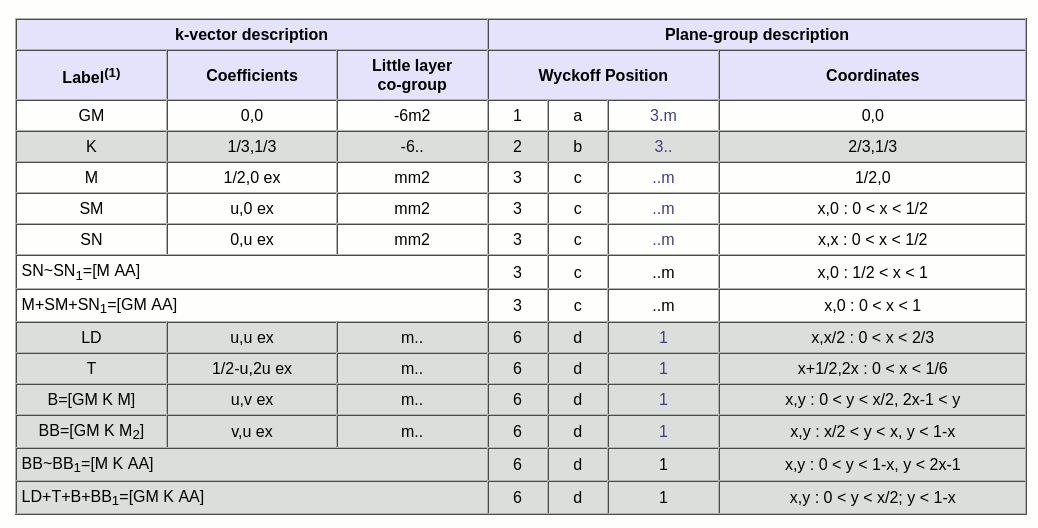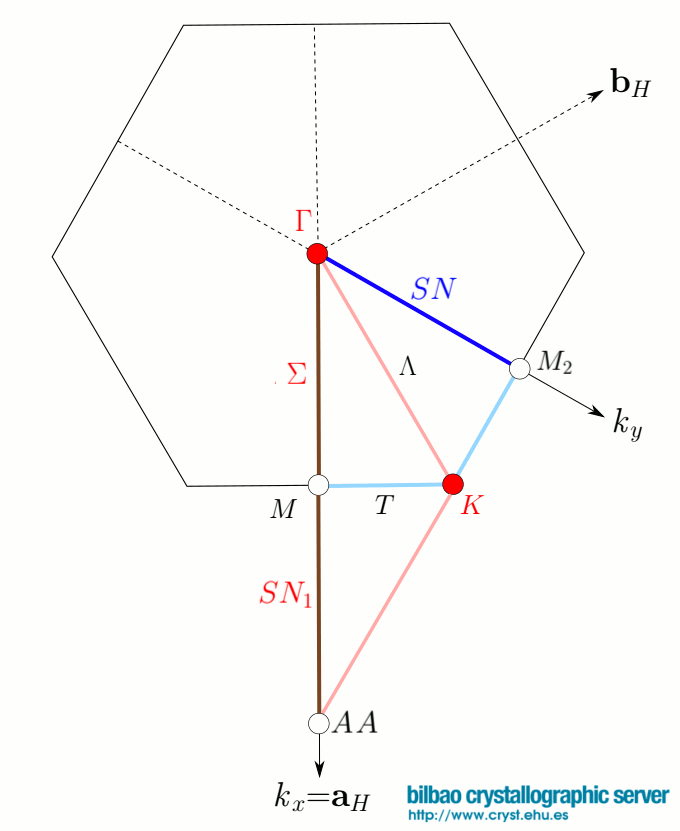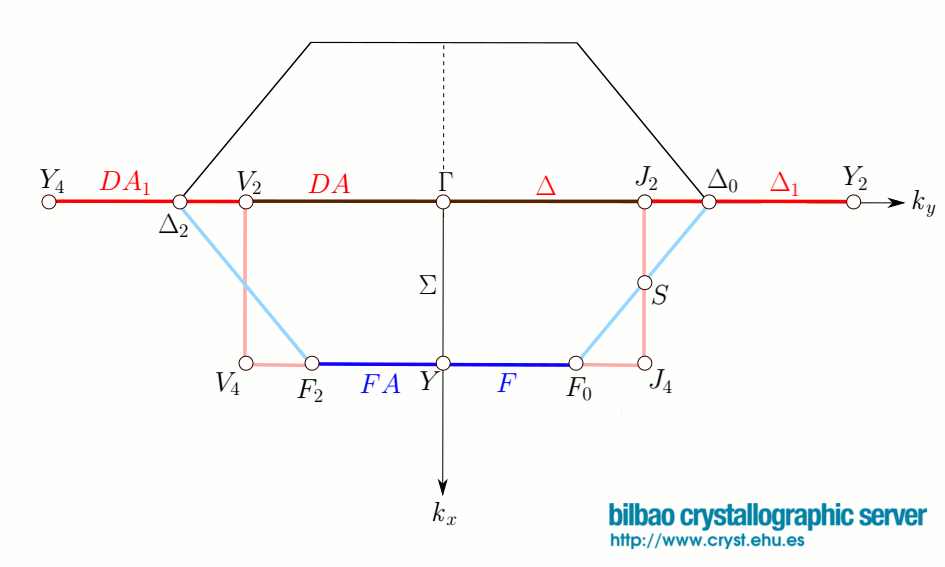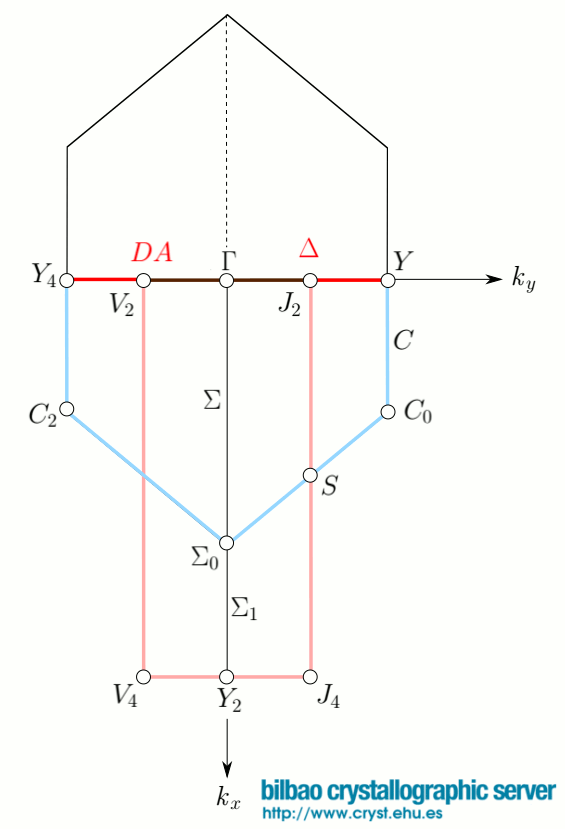 Help
Help
Bilbao Crystallographic Server
 Help Help
|
The k vectors of p-6m2 (No. 78) listed by L&W are distributed in four k-vector types: (i) the Wyckoff-position block 1a formed by the GM point, (ii) the block 2b formed by the K point, (iii) the k-vector point M and the k-vector lines SM and SN correspond to the block 3c, and (iv) the Wyckoff-position block 6d formed by the k-vector lines LD and T and the k-vector planes B and BB. The parameter description of a k-vector type is given in the last column of the table. Consider for example the line SM which, according to the ITA description, forms part of the k-vector type that is assigned to the Wyckoff position 3c with a site-symmetry group '..m'. Its parameter description x,0: -1/2 < x < 0 indicates that the independent segment of the line x,0 in the asymmetric unit is limited by the special k-vector points GM (x=0) and M(x=1/2) with x varying between 0 and 1/2. The parameter descriptions of the uni-arm regions (for a discussion of uni-arm description the reader is referred to [3]) of the k-vector types are shown in the last row of the corresponding Wyckoff position block. For example, in the block for position 3c, the k-vector line SN is equivalent (by a threefold rotation) to x,0 : -1/2 < x < 0 which in turn is equivalent (by a translation) to the line x,0: 1/2 < x < 1, denoted by SN1. This gives the uni-arm description M+SM+SN1 for the Wyckoff position 3c.

As the asymmetric unit and the representation domain do not coincide, their edges are coloured in pink and light blue, respectively. It has already been pointed out that k-vector points and lines are brought out in red only if they are special k-vector points and lines. For example, the lines T and LD (see figure of p-62m) are not coloured as special lines since they belong to the k-vector type of the Wyckoff-position block 6d, and their symmetry coincides with that of the neighbouring points of the symmetry plane B=[GM K M]. The point GM and K, however, are represented by red circles as they are special k-vector points. Likewise, the line SM is coloured in brown because it is an edge of the asymmetric unit and at the same time is a special k-vector symmetry line. The k-vector line SM is coloured in dark blue as it is a special symmetry line along the edge of the representation domain. As already indicated, the k-vector line SN together with SM and (see figure of p-62m) the point M belong to the special k-vector type of the Wyckoff-position block 3c, i.e. all these different wavevectors belong to the same k-vector type. Although M is explicity listed by L&W as a special k-vector point, it is represented by an open circle. In fact, it joins the symmetry lines SM and SN1 to a continuous line as its little co-group type coincides with those of the points on the lines.

The Brillouin-zone of the layer groups of the arithmetic crystal class m2mc is a non-regular hexagon. Depending on the relation between the lattice parameters a and b, two topologically different Brillouin zones are to be distinguished:


The k-vector tables show all special wave-vectors with their coefficients and layer little co-groups as specified in Tables 24 and 25 of L&W. The wave-vector coefficients with respect to the conventional reciprocal basis, i.e. dual to the conventional centred basis, are listed in the column under the heading 'Conventional' of the k-vector tables. For example, a k-vector point of the DT line with primitive coefficients (-1/4,1/4) is described as (0,1/2) with respect to a basis dual to the conventional basis cm2m.
The point GM, Y2 and S (acute case) and GM, Y and S (obtuse case) are not special k-vector points but form part of special lines and planes and in the diagrams they are represented by open circles. The line SM is not a symmetry line and is represented by a think black line because it is located inside the Brillouin zone. The lines DT and DA are coloured in brown because they are symmetry lines and at the same time are edges of the asymmetric unit. Part of DT and DA are also coloured in red because they correspond to flagpoles (for a discussion of flagpoles the reader is referred to [3]). The k-vector lines F and FA (acute case) are coloured in dark blue as they are symmetry lines along the edges of the representation domain.
Because of the special shape of the Brillouin zone and the representation domain for the acute case (a > b), the special k-vector line corresponding to the Wyckoff-position block 2a splits into several segments: the lines DT and DA, located inside the Brillouin zone, and the lines F and FA (coloured dark blue) at the border of the Brillouin zone. For the description of the end points of the segments, it is necessary to introduce additional parameters as dt0 and f0 whose values depend on the specific relations between the lattice parameters. The use of flagpoles enable the uni-arm description: the flagpole [J2 Y2] 0,y : 1/4 < y < 1/2 is equivalent to the segment [V4 Y] 1/2,y: -1/4 < y < 0 and the flagpole [V2 Y4] 0,y : -1/2 < y < -1/4 is equivalent to the segment [Y J4] 1/2,y : 0 < y < 1/4. The uni-arm description of the k-vector type of the Wyckoff position 2a is shown in the last row of the Wyckoff-position block and it is formed by the union of the points GM and Y2, the lines DT, DA, DT1 (∼ FA) and DA1 (∼ F). Its parameter description (0,y) with y varying in the range (-1/2,1/2) coincides with that of the acute case. The parameter description of the flagpole and its parameter range with respect to the basis of the reciprocal group are given below the k-vector table.
|
Bilbao Crystallographic Server www.cryst.ehu.es |
For comments, please mail to cryst@wm.lc.ehu.es |